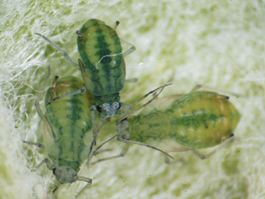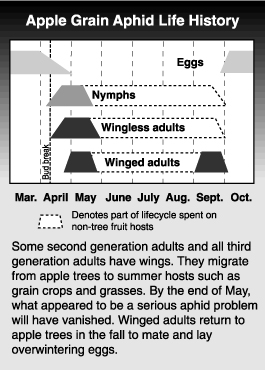by Michael J. Willett, originally published 1993
Rhopalosiphum insertum (Walker) [=fitchii (Sanderson)] (Homoptera: Aphididae)
The apple grain aphid (aka apple-grass aphid) is the most conspicuous aphid in apple orchards in the early season. It appears at the green tip stage before eggs of other aphids have hatched. Though it can be alarming to see buds completely covered with the dark green aphids, they do little damage to apples. In fact, their presence encourages aphid predators to build up early in the spring, increasing the potential for natural control of other aphids that appear later. Its early appearance, its location on the buds, and the dark green stripe on its body help distinguish the apple grain aphid from other aphids found on apples.
Hosts
The apple grain aphid prefers apple as an overwintering site but also overwinters on pear, hawthorn, plum and quince. Grasses and grains are preferred summer hosts.
Life stages

Egg
The egg is small, oval and shiny. Though dark green, it cannot easily be distinguished from other aphid species’ eggs. Eggs are laid on small branches, fruit spurs and terminals.
Nymph
The newly hatched nymph is dark green at first but turns lighter green. It has short cornicles or protuberances at the end of its abdomen.
Adult
The older nymph and adult is light green with a darker green stripe down the middle of the back and crossbars of the same color.
Life history
The apple grain aphid overwinters on apple trees as an egg near buds or on terminals, fruit spurs or larger branches. During the pruning season, eggs are often found by the hundreds. Eggs begin to hatch in spring when apple buds show the first green tissue. Nymphs feed on opening leaves, usually on spurs rather than watersprouts or terminals. Newly hatched aphids can be killed by unusually cold spring temperatures.
 The nymphs mature into wingless females that produce young without fertilization. One female can produce 100 offspring. Most second generation apple grain aphids have wings and migrate to summer hosts such as grain crops and grasses. The second generation aphids without wings produce a third generation. Those adults all have wings and begin to migrate from the apple trees about petal fall. By the end of May, what appeared to be a serious aphid problem will have vanished. The aphids produce several more generations on the summer hosts. Winged females return to apple trees in the fall. Males migrate back to the orchard in late fall and mate with the females, which lay overwintering eggs on apple twigs.
The nymphs mature into wingless females that produce young without fertilization. One female can produce 100 offspring. Most second generation apple grain aphids have wings and migrate to summer hosts such as grain crops and grasses. The second generation aphids without wings produce a third generation. Those adults all have wings and begin to migrate from the apple trees about petal fall. By the end of May, what appeared to be a serious aphid problem will have vanished. The aphids produce several more generations on the summer hosts. Winged females return to apple trees in the fall. Males migrate back to the orchard in late fall and mate with the females, which lay overwintering eggs on apple twigs.
Damage
Although the bulk of aphid eggs found on the tree may be apple grain aphid and nymphs can completely cover opening buds, its feeding does not damage the buds. When aphid numbers are high, leaves may curl slightly. Occasionally, large numbers of aphids may move to young fruit to feed which can cause bumpy, distorted fruit.
Biological control
Little is known about biological control of this aphid except that it is a food source for many of the generalist predators and parasites that feed on other aphid species colonizing apple.
Management
The apple grain aphid usually does not need to be controlled. Its presence can be beneficial, as it may encourage aphid predators and parasites to build up in early spring, increasing chances of natural control of pest aphids appearing later.
